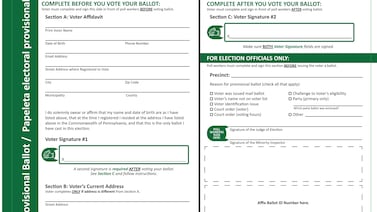Votebeat is a nonprofit news organization reporting on voting access and election administration across the U.S. A version of this analysis was originally distributed in Votebeat’s free weekly newsletter. Sign up to get future editions, including the latest reporting from Votebeat bureaus and curated news from other publications, delivered to your inbox every Saturday.
Hi, y’all,
This week, Republicans in Gillespie County, Texas hand counted every single one of the ballots cast in their primary. There were about 8,000 ballots, each of which contained choices for more than 30 races. It took around 200 people 21 collective hours to count all of the ballots, and Votebeat departed the Gillespie County Elections office at 5:12 a.m on Wednesday after watching the effort.
It was a long night, and one that Texas Republicans are portraying as a success. A local conservative website praised the effort: “Following months of preparation, hundreds of volunteers helped count thousands of paper ballots within 24 hours.”
Most of the words in that sentence are accurate. Beyond the basic facts of that statement, however, there’s much more we’re unable to verify, despite being the only two non-election workers present for the duration of the process. We watched the ballots be counted, we watched them be delivered to the elections office, and we watched as — around 4:30 a.m. — the last precinct turned in its results.
You would assume we’d know a lot about Tuesday’s process, but we don’t. What worries us most: There is likely no way to know what the error rate for this hand count is, and there is ample evidence the county party diverged from typical procedure — including their own admission that there were errors.
In a video posted on social media Thursday night, Tom Marschall, who was the Precinct 1 judge in Gillespie County, said errors were made during the count. But he didn’t see a “significant” problem with that, he said in the video. “What is significant concerning the errors is that they were seen and they were corrected before information went forward.”
Marschall’s wife, who was a counter of mail ballots, said in the video that one team didn’t follow the training “protocol” and that led to delays to count a batch of 50 ballots. “I was not impressed with that team. So I think the training needs to be more thorough. And maybe the trainers need to explain why they’re doing it the way they’re doing it,” she said,
We have no idea what process was followed in the room where mail ballots were counted — a tasting room at a local winery. It’s worth noting, though, that county GOP officials repeatedly told us throughout the day that counters had undergone “six months” of training. Some candidates told us they were confident counters knew exactly what they were doing.
Media were not allowed to watch from inside the winery or any of the precincts — by law only the counters, poll watchers, and election workers could be in the room — and Votebeat reporter Natalia Contreras was turned away from the practice session she attempted to enter on Saturday. Despite Natalia sitting in front of the chairman of the Republican Party all night long at the elections office, he couldn’t tell us exactly how many counters were at each precinct, who they were, or whether even recent recruits completed a full course of training. The workers at the winery, where Jessica was stationed on a patio looking in through a window, would not answer questions.
State law is also not conducive to ensuring that these results were accurately counted and reported. Texas requires partial recounts only for ballots that are tabulated electronically — there is no provision in state law to require the local GOP to recount these ballots or audit the results. Likely, a losing candidate would have to sue, but there weren’t very many close races: Just one sheriff’s race is headed to a runoff. Many of the candidates on that ballot also explicitly endorsed hand counting, so they’re unlikely to complain about it now.
What we have written above is the entirety of what we understand about the process. To the credit of the county GOP, the evening was orderly and the ballots were turned in on time. But from what we were able to observe, it did not follow the same steps to ensure quality hand counting both set into state standards and also demonstrated by another Texas county hand counting ballots at the same time.
One volunteer told the conservative publication above that “each team could count a batch of 50 ballots in about one and a half hours.” Let’s do some math.
If we assume that she is correct, that’s less than 2 minutes per ballot. On each ballot, there were at least 35 contests, meaning that human teams of five examined the ballot, and agreed on what it said in around three seconds per contest. That’s really hard to believe: Voter intent (because they initially selected the incorrect candidate or didn’t follow the ballot directions and marked the ballot unclearly) is sometimes hard to divine and must be decided by a committee.
“Given the speed of this count, I worry about its accuracy,” said Charles Stewart, a professor of political science at MIT who studies election administration and has published peer-reviewed studies on hand counting.
This is much faster than hand counts that have previously been done. By a lot.
Cathy Darling-Allen is the elections clerk in Shasta County, California. Her county leaders have been advocating for hand counting since 2020, and last September she prepared a detailed report on how much time it would take after studying the process for months. It took trained staff an average of 75 minutes to tally batches of 25 ballots, and then they took an additional nine minutes to audit those results.
Told of the Gillespie GOP’s counting rate, Darling-Allen expressed skepticism. “Without any audit at all, I would say the results have no validity,” she said.
None of the public comments or interviews of individuals associated with Gillespie County’s count have explained what steps they followed when voter intent wasn’t clear, or when teams disagreed on ballot marking.
In Travis County, home to Austin and not far from Gillespie County, Republicans elected to hand count only mailed ballots. This represented a small fraction of the total ballots cast there, coming to just under 2,000 ballots. They finished counting those ballots around midnight.
Then they began hours of quality checking the results, entering them into spreadsheets. This process took another eight hours, according to a GOP official and county election workers. The entire process was video recorded.
Based on what we saw with our own eyes, that is not how things went in Gillespie County.
Precincts counted ballots on site, while early and mailed ballots were counted at the winery. We watched as their materials were loaded into boxes, and then driven directly to the elections office to be returned. There, precinct judges — the people who supervise each polling location — turned in paperwork that included the totals the counting teams had reached, and left. We watched that, too. Some of those judges had to drive back to the elections office after they were informed they’d forgotten to fill out information or missed a signature.
There was a lot we couldn’t watch, and there was a lot that no one watched. While we could watch the counting being done at the winery through a window, none of the precincts were open to us by law. Candidates told us they had a hard time getting enough volunteer poll watchers to watch counting in 14 separate locations, much less for so many hours. Gillespie County Republicans also did not set up live streams of any of the counting, as Travis County Republicans did.
So, let’s sum that up: In an effort to increase transparency and reliability, Gillespie County Republicans counted ballots without publicly explaining how, in a manner that appears not to have followed standard practice, and they wouldn’t answer questions about how it worked while the counting was happening. They finished counting more ballots in a shorter amount of time than a Republican party nearby that was also hand-counting ballots, and did not follow at least some of the accuracy and transparency steps that the other county took along the way. No one from the county elections office watched.
The public is left with few options to ensure that the counted results were the results the county’s voters intended. We have requested the tally sheets and the notes and every other public document that should be made available to us under law, and we’ll review them thoroughly with a bipartisan slate of election officials to see what we can reconstruct.
There is nothing that specifically allows the county elections office to check the results, since in Texas primaries are party functions.
You’ll read more from Natalia in the coming weeks and months about hand counting in Gillespie County, and we’ll try to answer some of the lingering concerns we and others have about transparency and credibility. In that spirit: We know some of those who were involved in this hand count — as administrators, as poll watchers and campaign volunteers — read this newsletter. We’d like to talk to you about how this went, so that we can know with more certainty whether it actually was the success they have claimed this week.
As established above, we have lots of reasons to think it may not have been as straightforward a success as Texas Republicans are claiming. Certainly, the lack of clarity around the process is in stark contrast with the amount of transparency the same activists have loudly demanded of Gillespie County election workers.
And, finally, there is one crucial error in the quote from the above conservative news organization: There were no “volunteers.” By law, every counter was paid $12 an hour for that work, and — as the organization notes — there were hundreds of them. Taxpayers will foot the bill for those paychecks, since the state of Texas will be reimbursing the local party for the cost of this effort. This was hugely expensive, and Gillespie County Republicans are not paying for it — the whole of Texas is.
If you’ve got any insights, reach out. And please stay tuned.
Jessica Huseman is Votebeat’s editorial director and is based in Dallas. Contact Jessica at jhuseman@votebeat.org.






